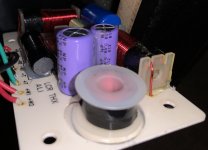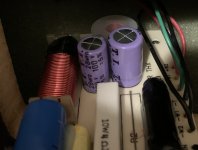My circa 1994 Klipsch CF1 floorstanding speakers have crossover boards which contain a couple of electrolytic caps which have values that I’m unable to find replacements for.
Specifically:
Markings show T.I. Which I believe is Tecante. Mmmm beer.
28MFD +/- 5% 100v
40MFD +/- 5% 100v
I suspect these were custom made for Klipsch. (Sigh)
I’m out of my realm as it concerns electronic circuit behavior so please forgive if I’m being naive but I’ve read that as electrolytics age they morph and introduce an unintended amount of resistance. Is that a quality that can be measured with a modern Fluke dvm?
I do not have a schematic.
Much obliged.
Specifically:
Markings show T.I. Which I believe is Tecante. Mmmm beer.
28MFD +/- 5% 100v
40MFD +/- 5% 100v
I suspect these were custom made for Klipsch. (Sigh)
I’m out of my realm as it concerns electronic circuit behavior so please forgive if I’m being naive but I’ve read that as electrolytics age they morph and introduce an unintended amount of resistance. Is that a quality that can be measured with a modern Fluke dvm?
I do not have a schematic.
Much obliged.
Attachments
Last edited:
You can measure the capacitors with a capacitance bridge. A DVM can only tell you if they are short circuit or leaking and only with the components removed.
You will find they are more than likely within specification being designed with age in mind.
They are of course, Non Polarised which makes the build quality different to ordinary polarised electrolytics.
You will find they are more than likely within specification being designed with age in mind.
They are of course, Non Polarised which makes the build quality different to ordinary polarised electrolytics.
If regularly used, they may be due for replacement, having higher ESR and shifted in uF value.
The 28uF can be sub with a 25uF or 31uF instead.
https://www.madisoundspeakerstore.c...40-mfd-non-polar-electrolytic-capacitor-100v/
https://www.madisoundspeakerstore.c...25-mfd-non-polar-electrolytic-capacitor-100v/
https://www.madisoundspeakerstore.c...31-mfd-non-polar-electrolytic-capacitor-100v/
The 28uF can be sub with a 25uF or 31uF instead.
https://www.madisoundspeakerstore.c...40-mfd-non-polar-electrolytic-capacitor-100v/
https://www.madisoundspeakerstore.c...25-mfd-non-polar-electrolytic-capacitor-100v/
https://www.madisoundspeakerstore.c...31-mfd-non-polar-electrolytic-capacitor-100v/
This is a case where ESR measurement is useful. Home use capacitors might have been run at 1 w, never heated up, and never vented the water.
If the ESR is high, I would parallel a 22 and a 6.8 for the 28, and four 10 uf for the 40. Modern 20% tolerance caps generally are 10-15% low; saves the vendor material. Note in my experience dried up caps (high ESR) read a little high on the capacitance range.
The popular ESR meter is the Peak sold at farnell etc. https://www.newark.com/peak/72-12835/esr-meter-capacitor-1mf-to-22000mf/dp/56Y1286?st=esr meter Meter comes with a table of standard ESR for different sizes.
If the speaker is moved a lot, as bar band service, glue the capacitor bundles to the board with hot melt or silicon seal.
For an upgrade to non-expiring caps, Jantzen polyprophylene caps come in popular sizes: parts-express.com
If the ESR is high, I would parallel a 22 and a 6.8 for the 28, and four 10 uf for the 40. Modern 20% tolerance caps generally are 10-15% low; saves the vendor material. Note in my experience dried up caps (high ESR) read a little high on the capacitance range.
The popular ESR meter is the Peak sold at farnell etc. https://www.newark.com/peak/72-12835/esr-meter-capacitor-1mf-to-22000mf/dp/56Y1286?st=esr meter Meter comes with a table of standard ESR for different sizes.
If the speaker is moved a lot, as bar band service, glue the capacitor bundles to the board with hot melt or silicon seal.
For an upgrade to non-expiring caps, Jantzen polyprophylene caps come in popular sizes: parts-express.com
Last edited:
Like your suggestions, it’s hard to say how these speakers were abused when I was away for the weekend and the teenagers had their partiesThis is a case where ESR measurement is useful. Home use capacitors might have been run at 1 w, never heated up, and never vented the water.
If the ESR is high, I would parallel a 22 and a 6.8 for the 28, and four 10 uf for the 40. Modern 20% tolerance caps generally are 10-15% low; saves the vendor material. Note in my experience dried up caps (high ESR) read a little high on the capacitance range.
The popular ESR meter is the Peak sold at farnell etc. https://www.newark.com/peak/72-12835/esr-meter-capacitor-1mf-to-22000mf/dp/56Y1286?st=esr meter Meter comes with a table of standard ESR for different sizes.
If the speaker is moved a lot, as bar band service, glue the capacitor bundles to the board with hot melt or silicon seal.
For an upgrade to non-expiring caps, Jantzen polyprophylene caps come in popular sizes: parts-express.com
 .
.I’ll have to check out those Jantzen PP caps.This is a case where ESR measurement is useful. Home use capacitors might have been run at 1 w, never heated up, and never vented the water.
If the ESR is high, I would parallel a 22 and a 6.8 for the 28, and four 10 uf for the 40. Modern 20% tolerance caps generally are 10-15% low; saves the vendor material. Note in my experience dried up caps (high ESR) read a little high on the capacitance range.
The popular ESR meter is the Peak sold at farnell etc. https://www.newark.com/peak/72-12835/esr-meter-capacitor-1mf-to-22000mf/dp/56Y1286?st=esr meter Meter comes with a table of standard ESR for different sizes.
If the speaker is moved a lot, as bar band service, glue the capacitor bundles to the board with hot melt or silicon seal.
For an upgrade to non-expiring caps, Jantzen polyprophylene caps come in popular sizes: parts-express.com
This is a case where ESR measurement is useful. Home use capacitors might have been run at 1 w, never heated up, and never vented the water.
If the ESR is high, I would parallel a 22 and a 6.8 for the 28, and four 10 uf for the 40. Modern 20% tolerance caps generally are 10-15% low; saves the vendor material. Note in my experience dried up caps (high ESR) read a little high on the capacitance range.
The popular ESR meter is the Peak sold at farnell etc. https://www.newark.com/peak/72-12835/esr-meter-capacitor-1mf-to-22000mf/dp/56Y1286?st=esr meter Meter comes with a table of standard ESR for different sizes.
If the speaker is moved a lot, as bar band service, glue the capacitor bundles to the board with hot melt or silicon seal.
For an upgrade to non-expiring caps, Jantzen polyprophylene caps come in popular sizes: parts-express.com
That Peak ear meter seems like a pretty affordable and useful tool if you do a lot of rebuilding.
Thanks for the ideas.
Thanks for the ideas.
You want to watch out replacing electrolytic caps with film, as the inherent ESR of the electrolytics will exert a damping effect on the filter - replacing the electrolytics with film caps will alter the Q of the crossover, and not in a good way. A better approach would be to use the film caps, but to add a series resistor equivalent to the electrolytic ESR in series with the film cap. Too bad the crossover is old, as you may not get an accurate/original ESR reading from the aged caps.
- Home
- Loudspeakers
- Multi-Way
- Klipsch CF1 crossover aging

